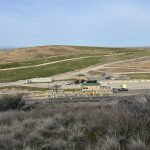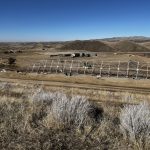Hidden Hollow Cell
The Ada County Landfill began accepting waste in 1972. Over the course of the next 45 years, this landfill would accept 12,400,000 cubic yards of waste weighing approximately 7,770,000 tons from Ada County. In 2017, the Hidden Hollow Cell (HHC) received its last load of trash. In 2018, the Ada County Solid Waste Department began the process of permanently closing the HHC. Once the cell was closed, it was capped off with 4-6 feet of topsoil then hydroseeded with native plants. Over 371 vertical wells were drilled into the landfill to capture landfill gas that is currently being utilized as electricity for nearly 3,000 homes. Landfills must be monitored for at least 30 years after closure.
Hidden Hollow Cell today:

North Ravine Cell
The North Ravine Cell was commissioned by the Board of Ada County Commissioners in 2004 when the Hidden Hollow Cell (HHC) was reaching capacity. The site for the new landfill is located directly north of the HHC, dubbing the new landfill the North Ravine Cell (NRC).
The NRC is being constructed in stages. Stage 1 was constructed in 2007 and Stage 2 in 2010. The construction of Stage 3 began in 2018 and is nearing completion. Stage 4 has been simultaneously excavated to prepare the site for use and to provide the soil needed to cover the compacted trash at the end of each day. However, alternative daily covers are being evaluated to help save space and extend the life of the landfill. The construction of the foundational base of Stage 4 is projected to be completed and ready for garbage deposits in 2024. Topsoil, which is set aside and saved for the final cap, is being removed from Stage 5. There will be roughly 26 stages of various sizes when the NRC is closed and capped off. Exactly when that will be depends on how much trash needs to be deposited in upcoming years.
The NRC exemplifies the latest in safe and environmentally compliant landfill technology and engineering. As each bottom stage is constructed, a thick, puncture resistant liner is placed upon carefully compacted soil, layers of gravel, and fibrous materials. Additionally, the bottom stages are sloped to allow leachate to drain to a system that pumps it into evaporation ponds. As the stages are built in layers (lifts), horizontal gas lines are installed and connected to the extraction system for landfill gas (LFG). Landfill gas primarily contains methane and carbon dioxide, significant greenhouse gases. LFG is a naturally occurring biproduct of landfill decomposition. Capturing these gases is vital to the protection of the atmosphere. At the Ada County Landfill, LFG is used in two large generators to produce electricity and will soon be diverted as a source of Renewable Natural Gas. What cannot be utilized is burned off in flares.
The NRC was engineered to last 100 years but with the rapid growth in Ada County, it will likely serve the community for fewer than 60 years. Learning more about Diversion (keeping waste from the landfill) through recycling, reuse, and reducing waste is critical to extending the life of the current landfill, slowing the need to establish a future landfill elsewhere.
North Ravine Cell today:

Interesting Facts
- Hidden Hollow Cell accepted 7,770,000 tons of waste from 1972 to 2017
- North Ravine Cell took in 535,795 tons in 2021 alone


